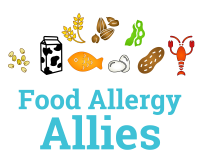What is a food allergy?
A food allergy is a medical condition defined as an irregular immune response to a particular food. A food allergy develops when a person’s immune system misidentifies harmless food proteins as dangerous threats. As a result, the immune system releases special chemicals to combat the so-called threat, and these chemicals cause a number of symptoms. If the problem-causing food is ingested (or even touched), it can cause symptoms including an itchy mouth, stomach pain, trouble breathing, and even death.
What is an allergen?
An allergen is a food that triggers an allergic response. An allergic reaction occurs if the allergen is eaten, touched, or inhaled. The nine most common allergens in the U.S are milk (dairy), eggs, peanuts, tree nuts, soy, wheat, fish, shellfish, and sesame.
How common are food allergies?
- Food allergies affect over 32 million Americans
- 1 in 13 children has a food allergy
- 1 in 10 adults has a food allergy
- Every 3 minutes, a food allergy reaction sends someone to the emergency room
Is there a cure for food allergies?
If someone is currently experiencing an allergic reaction, treatments include antihistamine pills for mild reactions or an epinephrine injection for more severe reactions. For long term solutions, there is currently no cure for food allergies. However, there are a variety of emerging treatments that can help avoid or minimize allergic reactions. Complete avoidance of the food trigger has long been the only effective course of treatment, but modern innovations in science have sparked new treatment plans such as oral immunotherapy (OIT). OIT aims to lessen the severity of an allergy by means consuming an increasing amount of the allergen each day in order to eventually build up a tolerance.
What is anaphylaxis?
Anaphylaxis (a-nuh-fil-LAX-is) is the name for a very severe allergic reaction, often identifies by symptoms such as trouble breathing, reduced blood pressure, loss of consciousness, or death. Anaphylaxis reactions should be treated as quickly as possible with an epinephrine auto-injector and a call to 911.
Click here for more information about food allergies
Article sources:
https://www.foodallergy.org/resources/what-food-allergy
https://medlineplus.gov/foodallergy.html
https://www.foodallergy.org/resources/anaphylaxis
DISCLAIMER: This article is meant to be used for general education on the topic of food allergies, and is not intended to be a substitute for the knowledge of a licensed healthcare professional.

